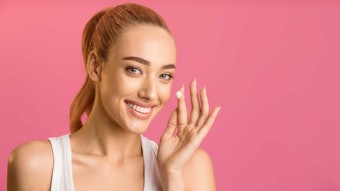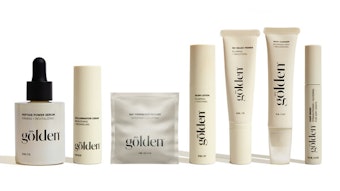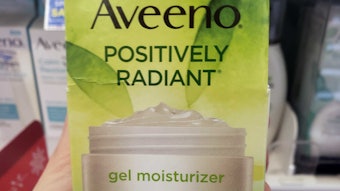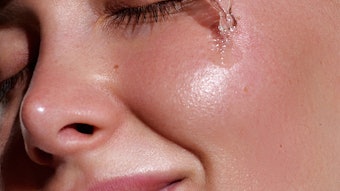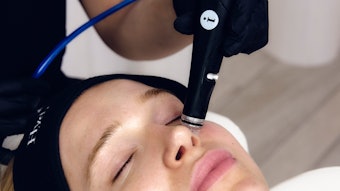Clarice’s Creating Beautiful Looks 326 S. Main Street, Wheaton, Illinois USA tel: 630-690-2266
Clarice: “Back bar” at a spa is what is considered your facial room, your technician room products. So it’s the professional products or the professional strength. Some of those products, like some from YG Laboratories, are not sold retail; those are considered professional products only. In the treatment room we sell products at retail sizes (8 oz, 16 oz). The professional products are in bigger bottles and maybe higher strengths. For example, the professional strength AHAs are 20% and 30%, versus retail strength at 10%.
Clarice: As a spa person, I think it’s important for the product supplier to give you training on their product as far as what the ingredients are and how are they working, and why they are at the percentages they’re at. Basically, that’s good product knowledge. There’s a lot of classes out there on marketing, managing your desk help. The spa industry has not put enough importance on the training of their front desk help because that front desk help needs to know everything the estheticians know about the products because they’re the customer’s first contact in the spa; if front desk doesn’t understand the treatments being done and the ingredients being used, I think that’s a problem.
C&T: What job functions are there in a spa?
Clarice: Spa owner, esthetician, front desk help, massage therapist, nail technicians. Technically a spa does not do hair, but a lot do. Often there’ll be a makeup artist. There’s crossover; a massage therapist might do the body treatments, but an esthetician also could do body treatments. Esthetician could be a makeup artist. Makeup artists now have to be licensed if they’re working in a spa, so most of them are estheticians. An esthetician is a skin care technician. She has gone to school specifically to concentrate on doing skin care.
C&T: You say you want some guidance on which products offer real benefits and which products are hype. Can a formulator help you with that?
Clarice: Yes, but there’s not a lot of formulators out there doing classes except for Rebecca Gadberry. Need more like her. For example, in her class upcoming at the Midwest Show, she doesn’t tie her presentation to her company at all. She’s the only one out there who gives nonbiased information. When I went on the Obaji website, I’m like which of these products work and which are hype, and what kind of lines are they selling the doctors? They claim 20% vitamin C in their product; I’ve learned from Rebecca’s class that vitamin C is extremely hard to stabilize, and it’s never stable at over 2% in a product. So why would you put it at 20%? Plus the skin can only absorb 2%. So I’ve had nonbiased training, but the average person hasn’t had that training. She packs them in when she gives these classes, and her UCLA class is filled to capacity, but still a lot of spa people don’t go to classes. Here in the Midwest I find many people in salons who took one class from Rebecca 12 years ago and they think they know it all; not true; the technology just for skin care has changed a lot just in the last two years. So companies are doing training, but too many spa people aren’t going to the training. A lot of the reason for that in the Midwest is family time, which is a higher priority here than other places in the country. A lot of the Midwest shows compete with high school graduations and dances at the same dates. It’s hard to get people into classes on Sundays because that’s a family day. It’s hard to get them into classes on Mondays because that’s technically their only day off. Training’s out there; it’s just who’s taking advantage of it. I wish there were more trainers like Rebecca that give classes strictly on ingredients without any connection to a company. I don’t expect that to happen because what financial motivation does the company have to do that? As it is now, you have to hope that the companies are giving you honest answers. I have an issue with a lot of these doctor lines. My sister is a wound-care specialist nurse. She is a Midwest rep for a company that has just developed a wound-care machine that she trains people on. In that training people are taught to treat the subcutaneous layer of the skin and the dermis. They’re not taught to treat the epidermis. They forget a lot of times there’s a cosmetic issue on top of that. Another issue. A lot of dermatologists saw that a lot of people were coming to the cosmetician for advice and taking some of the market away from the dermatologists, so the derms started adding estheticians. Derm docs are putting in the medi-spas because a lot of their services aren’t covered by insurance any more. So in order to recapture that market for esthetician services, the docs have put estheticians in the doctor’s offices. But that doesn’t make their products any better because they still buy products according to what those companies tell them and who’s giving them more samples and what the latest hype is out there. Derm docs used to tell patients to use Clinique because it was the only hyperallergenic product out there. Well, it wasn’t the only such product, but it was the one that was marketed the best. But that product contains almost pure acetone as a clarifying astringent; it’s stripping the skin; it’s stripping the moisture barrier; if your don’t protect, repair or replace the moisture barrier you’re not going to be able to take care of the problems topically on the skin.
C&T: So the esthetician treats the surface of the skin. The derm docs treat the dermis.
Clarice: Technically that is correct. If estheticians say we’re treating the dermis, then we’re making a drug claim. But by the way, the peptides really are working in the dermis; we have to be careful there; we can’t come out and say that.
C&T: Yeah. A medical formulator at Young said peptides work in the lowest levels of the epidermis where the fibroblasts are living. Clarice: Well, my understanding is that the peptides work mostly in the epidermal junction, so that’s probably a safe way for companies to say the peptides are working within cosmetic limits. i.e., is the epidermal junction technically the epidermis or is it the dermis? I would go with the Young version because that’s a safer statement for us in this industry.
C&T: So you like training in formal classes. What about handouts, sample, before and after photos. Do they play a role in training? Clarice: We need it all. If you’re telling me a specific ingredient does A, I want to see before and after pictures showing it does what you say. When the raw ingredient suppliers YG uses present an ingredient to Rebecca, they show the before and after slides. She is very particular about the b&a pictures and uses them in her presentations. Yes, spa people are very visual people. That’s why b&a pictures and classroom presentations work for us. I tried to read C&T magazine once, but I couldn’t follow it at all. Too technical. I need stuff simple; in bullet form. Spa people want to know the science, and it’s hard to find (compared to stuff on the business side of spas); but we need it a form that’s understandable to us. And there are so many conflicting internet sources; sites that downplay ingredients; sites of people who think they need to protect the world from cosmetics. It’s a matter of people being smart about what websites they go on. I have a big advantage there because of my connection with a company like YG. Anyone who carries their products has an advantage. At her classes Rebecca hands out a list of websites she finds are honest. Available is another issue. A spa owner has to manage staff, do the marketing, etc. You don’t always have time to sit down and research ingredients. That’s why spa owners should take advantages of the classes that are offered. The classes are offered to help people out, but it’s very hard to get people in ‘em.
Clarice: The Midwest Beauty Show is in March, so this April article is too late to promote it. But you should be promoting the Face & Body show in August and the American Expo in October. For C&T, especially American Expo, which is co-sponsored by Skin Inc and the Chicago Cosmetology Association. A lot of the manufacturers read C&T. There are some great classes offered at that show. They have speakers. This year the Midwest Show has speakers from the American Association of Esthetics Education; four people give a class; the classes must not be product-specific. F&B has classes all day on the first day of F&B; those classes are non-product classes; Linda and others pre-review each presenter’s PowerPoint and delete anything too product specific or too much like a drug claim. Those are the three best shows: Midwest, F&B and American Expo; the last two are Skin Inc shows and they’re the best because of their non-product classes. But Saturday classes at the Skin Inc shows are tough because spa people find it hard to take Saturdays off. Mondays aren’t good because that’s the last day and the manufacturers are leaving. It’s a tough call. Also, manufacturers can buy their own classrooms at the shows and present whatever they want there, even it if is product-specific.
C&T: When you were selling cosmetics in the drug store, what kind of training did you get for that?
Clarice: When I sold Elizabeth Arden and Ultima, they had classes 2-3 times a year that they would send you to. I got a lot of my basic skin care training there. In those days, Arden products were manufactured by Ely Lilly. We learned great technology then and it’s back in the industry now, but it went by the wayside when Faberge bought Arden. It was a manufacturer’s class, geared to the products they produce, but it had a lot of good information there. The best training I got in the drug store was seeing the customers come back day after day. A customer would come in directly from a derm doc who recommended Product A, B and C; a few days later the customer would come back and I could track the product’s results, and if necessary suggest Product D instead. So my drug store training was from manufacturer classes, learning the products on the shelves, seeing what the derm doc prescribed/recommended, and also talking with the pharmacist. You won’t get that kind of training any more in pharmacies, because they don’t have those cosmetic-type departments with the beauty experts.
C&T: Talk about the five peptide products YG planned to launch in 2006.
Clarice: They not only planned it; they did it. • Peptide Firming Eye Cream • Lip Remodeling Cream • Firm & Repair Throat Cream and Neck Cream • Line Smoothing Filling Pen • Restylin is an injection treatment from the derm doc who injects spheres of hyaluronic spheres that swell under the skin and push the wrinkle up from below. YG’s pen has the peptide technology in it but it also has liposomes containing dehydrated hyaluronic acid. The liposomes can get down into the intercellular layer and absorb the skin’s water and prevent its evaporation, and swell with that water to push up the wrinkle. The peptides are delivered into the skin using receptors on the peptide that are able to lock onto the cell and then enter into the cell.
C&T: Who do you train?
Clarice: I train spa owners and estheticians who are using YG products or are planning to use them. These are products for both back bar and retail. A lot of companies will tell you “You have to use every product in our line; you can’t use products from outside our line with our products because the outsiders won’t work.” First, I don’t think it’s true. A company named Janet Sarten, still out there I think; she’s department store only. She would say you can’t use other-line products with hers because they will counteract the effects of her products in her line; but that was really more of a marketing tool. If you use cleanser, tone and moisturizer all from one line, she said those products are all formulated to work on top of each other so one’s gonna strengthen the other. YG systems are created so you can use a YG product with products from any other line. Rebecca formulates for other companies, so she’s not gonna tell people the only products they can carry in their salon are her products because then she might be dissing somebody else she makes products for. She formulates her products so they enhance other products. When I’m in the treatment room, I don’t want to be limited to treating someone as either dry skin, oily skin or combination skin. Everybody’s skin is different. One person’s acne might be due to excessive oil; another might be due to bad food sensitivity; or another is hormone-induced; one might be genetic. The treatment differs from one person to the next. I can take a base cleanser; then I can add some astringents, or toners or serums (Power Plexes) into the cleanser to be able to treat the skin condition with keeping the skin tight in mind. Another reason for offering the classes is that spa people need to understand you can’t do a cookie-cutter facial. You can’t bring someone in and only have a choice of treating them as dry skin, oily skin or combination skin.
Clarice: What I’m seeing suggests that peptide technology is truly the next trend in the skin care industry. It’s less invasive. Even though it’s working in the dermis (or lower epidermis), it uses a more non-invasive procedure. AHAs, dermabrasion, they’re still invasive to the skin; they still cause inflammation and irritation. And we’re learning that inflammation is one of the fundamentals of aging. You may not see that inflammation. But when that inflammation cascade kicks into the skin, then all the enzymes that rip the skin apart go into action. How those enzymes go into action and what hormones are released to cause the inflammation all depend upon the genetic makeup of the person. I’m learning that peptides don’t cause inflammation, and they work to help build the collagen.
C&T: So customers come in to your salon. You don’t just treat them or pick a product for them. You also teach them about their skin. Clarice: We teach them about their skin, and that their skin can change on a daily basis.
C&T: What’s the biggest problem for you in your business?
Clarice: Biggest problem is I’m a small independent. I use what is technically a private label line so I don’t have the marketing behind me for the company. But I don’t want to use the products [from the big companies] because I want to be able to treat the person’s skin care needs. So I always go up against the companies that are out there doing the marketing promoting their product as better, and I’m going against the docs who people think have better products because the docs have the medical degrees. That’s why I pay for a lot of sampling. The customers need to try the products and find out that “Yes, she is indeed telling me the truth.” And then come back in. But marketing is hard to fight.
C&T: What’s the “sampling” expense about?
Clarice: I buy a lot of samples from the company. They’re technically travel sizes, so they’re like 1 oz containers that will last somebody almost 2 weeks; they’re recloseable; they’re not individual pouches. So someone comes in; I might recommend Product A to use over the next few weeks to follow up what I’ve done/used in the facial. They might have a product at home that technically is a good product, but it won’t give them the same results they told you they’re looking for. So at that point I’ll give them the sample, and say “I want you to try this. Give it 2 weeks. Come back. We do a consultation to see how it’s working.” I have to pay for those samples. Some are not cheap. Some companies give them to the salon, if that cost is part of the company’s marketing plan. But YG doesn’t include that cost in their marketing. For branded lines – a line that has your name on it – the spa owner has to pay for samples and do the marketing. YG gives us quality products, but it’s up to us to do the marketing. Most of the companies that give the samples are giving pillow packs, so it’s a one-time use. For my customers I need something for longer-term use.


